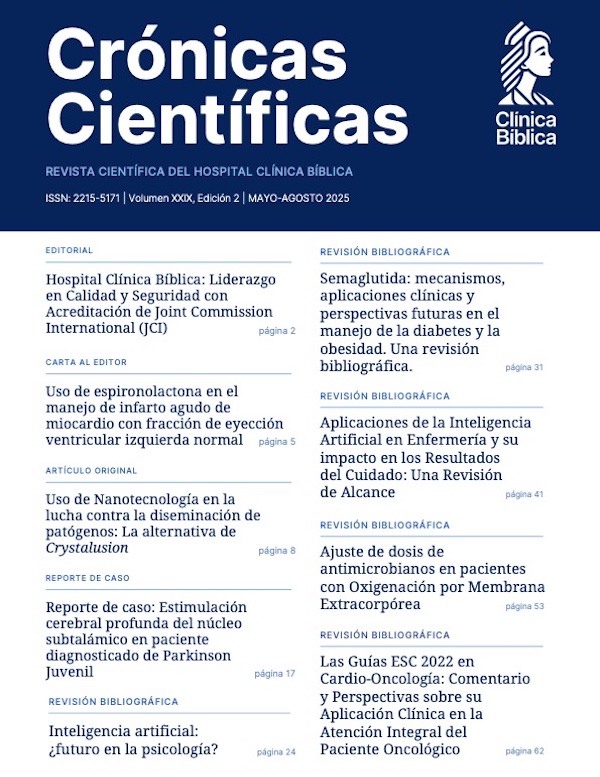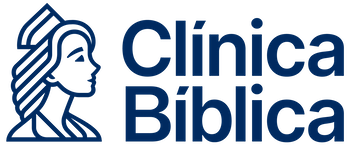- Visto: 3753
Revisión bibliográfica
Fisiopatología y Manejo del Evento Cerebrovascular Hemorrágico
Pathophysiology and Management of Hemorrhagic Stroke
Edición XXIII Enero - Abril 2023
DOI: https://doi.org/10.55139/COTE9510
APA (7ª edición)
Consumi, G., Navarro Morales, D., Soto Zúñiga, J. M., & Murillo Durán, A. (2023). Fisiopatología y Manejo del Evento Cerebrovascular Hemorrágico. Crónicas científicas, 23(23), 1-12. https://doi.org/10.55139/COTE9510.
Vancouver
Consumi G, Navarro Morales D, Soto Zúñiga JM, Murillo Durán A. Fisiopatología y Manejo del Evento Cerebrovascular Hemorrágico. Cron cient. 9 de setiembre de 2023;23(23):1-12.
Dra. Giuliana Consumi
Médico general.
Licenciatura en Medicina y Cirugía, Universidad de Ciencias Médicas (UCIMED). San José, Costa Rica.
Investigadora Independiente. San José, Costa Rica.
Dr. Daniel Navarro Morales
Médico general.
Licenciatura en Medicina y Cirugía, Universidad de Ciencias Médicas (UCIMED). San José, Costa Rica.
Investigador Independiente. San José, Costa Rica.
Dr. José Mauricio Soto Zúñiga
Médico general.
Clínica Santa Catalina, San José, Costa Rica.
Investigador Independiente. San José, Costa Rica.
Dr. Andrés Murillo Durán
Médico general.
Hospital Nacional de Niños, San José, Costa Rica.
Investigador Independiente. San José, Costa Rica.
Resumen
El evento cerebrovascular hemorrágico es considerada una patología a la que se le asocia una tasa de morbilidad, mortalidad y de discapacidad muy elevada.
A esta patología hemorragia intracraneal también se le adjunta las hemorragias intracerebrales y subaracnoideas.
Para el diagnóstico del evento cerebro vascular comúnmente se inicia con la clínica del paciente, posteriormente ante la sospecha se solicita una tomografía computarizada (TC), una resonancia magnética nuclear (RMN) o el eco de gradiente, cada uno con distintas especificaciones y sensibilidad para el diagnostico certero de dicha patología.
Esta patología puede ser tratada de distintas formas, tales como: la intervención quirúrgica, o se puede realizar un manejo médico, más conservador, esto dependerá del grado de afectación neurológica y sangrado intracraneal que el paciente presente.
Se ha demostrado que esta patología es prevenible, especialmente a través de hábitos saludables, cambios en el estilo de vida y atención médica regular, son la clave para reducir el riesgo de sufrir un evento cerebrovascular hemorrágico.
Palabras claves
Hemorragia intracraneal, hemorragia subaracnoidea, accidente cerebrovascular, cirugía, hipertensión.
Abstract
The hemorrhagic cerebrovascular event is considered a pathology associated with a very high rate of morbidity, mortality and disability.
This pathology intracranial hemorrhage is also attached to intracerebral and subarachnoid hemorrhages.
For the diagnosis of the cerebrovascular event, it commonly begins with the patient's symptoms, later, when suspected, a computed tomography (CT), nuclear magnetic resonance (NMR) or gradient echo is requested, each with different specifications and sensitivity for the accurate diagnosis of this pathology.
This pathology can be treated in different ways, such as: surgical intervention, or a more conservative medical management can be performed, this will depend on the degree of neurological involvement and intracranial bleeding that the patient presents.
It has been shown that this pathology is preventable, especially through healthy habits, lifestyle changes and regular medical care, they are the key to reducing the risk of suffering a hemorrhagic stroke.
Keywords
Intracranial hemorrhage, subarachnoid hemorrhage, stroke, surgery, hypertension.
Bibliografía
1. Cai Q, Li Z, Wang W, Ji B, Liu J, Chen Z, et al. Hemorrhagic stroke treated by transcranial neuroendoscopic approach. Sci Rep [Internet]. 2021;11(1):11890. Disponible en: http://dx.doi.org/10.1038/s41598-021-90927-8
2. Montaño A, Hanley DF, Hemphill JC 3rd. Hemorrhagic stroke. Handb Clin Neurol [Internet]. 2021;176:229–48. Disponible en: http://dx.doi.org/10.1016/B978-0-444-64034-5.00019-5
3. Unnithan AKA, Das J M, Mehta P. Hemorrhagic Stroke. 2022 [citado el 21 de enero de 2023]; Disponible en: https://pubmed.ncbi.nlm.nih.gov/32644599/
4. Wong Y-S, Tsai C-F, Ong C-T. Risk factors for stroke recurrence in patients with hemorrhagic stroke. Sci Rep [Internet]. 2022;12(1):17151. Disponible en: http://dx.doi.org/10.1038/s41598-022-22090-7
5. Chen C-Y, Lin P-T, Wang Y-H, Syu R-W, Hsu S-L, Chang L-H, et al. Etiology and risk factors of intracranial hemorrhage and ischemic stroke in young adults. J Chin Med Assoc [Internet]. 2021;84(10):930–6. Disponible en: http://dx.doi.org/10.1097/JCMA.0000000000000598
6. Kitagawa K. Blood pressure management for secondary stroke prevention. Hypertens Res [Internet]. 2022;45(6):936–43. Disponible en: http://dx.doi.org/10.1038/s41440-022-00908-1
7. Castello JP, Pasi M, Kubiszewski P, Abramson JR, Charidimou A, Kourkoulis C, et al. Cerebral small vessel disease and depression among intracerebral hemorrhage survivors. Stroke [Internet]. 2022;53(2):523–31. Disponible en: http://dx.doi.org/10.1161/STROKEAHA.121.035488
8. Gildersleeve KL, Hirzallah MI, Esquenazi Y, Moomaw CJ, Sekar P, Cai C, et al. Hemicraniectomy for supratentorial primary intracerebral hemorrhage: A retrospective, propensity score matched study. J Stroke Cerebrovasc Dis [Internet]. 2019;28(11):104361. Disponible en:
http://dx.doi.org/10.1016/j.jstrokecerebrovasdis.2019.104361
9. Gil C, Flores E, Cebrian R, Mendoza A, Gonzales L, Garcia M, et al. Essential topics about the imaging diagnosis and treatment of hemorrhagic stroke: A comprehensive review of the 2022 AHA guidelines. Curr Probl Cardiol [Internet]. 2022;47(11):101328. Disponible en: http://dx.doi.org/10.1016/j.cpcardiol.2022.101328
10. Greenberg SM, Ziai WC, Cordonnier C, Dowlatshahi D, Francis B, Goldstein JN, et al. 2022 guideline for the management of patients with spontaneous intracerebral hemorrhage: A guideline from the American heart association/American stroke association. Stroke [Internet]. 2022;53(7):e282–361. Disponible en: http://dx.doi.org/10.1161/STR.0000000000000407
11. O’Donnell MJ, McQueen M, Sniderman A, Pare G, Wang X, Hankey GJ, et al. Association of lipids, lipoproteins, and apolipoproteins with stroke subtypes in an international case control study (INTERSTROKE). J Stroke [Internet]. 2022;24(2):224–35. Disponible en: http://dx.doi.org/10.5853/jos.2021.02152
12. Fekadu G, Chelkeba L, Kebede A. Risk factors, clinical presentations and predictors of stroke among adult patients admitted to stroke unit of Jimma university medical center, south west Ethiopia: prospective observational study. BMC Neurol [Internet]. 2019;19(1):187. Disponible en: http://dx.doi.org/10.1186/s12883-019-1409-0
13. LeivaC, Wintermark M, Kidwell C. Neuroimaging of cerebral ischemia and infarction. Neurotherapeutics [Internet]. 2011;8(1):19–27. Disponible en: http://dx.doi.org/10.1007/s13311-010-0004-2
14. Lu J, Mei Q, Hou X, Manaenko A, Zhou L, Liebeskind DS, et al. Imaging acute stroke: From one-size-fit-all to biomarkers. Front Neurol [Internet]. 2021;12:697779. Disponible en: http://dx.doi.org/10.3389/fneur.2021.697779
15. Torres E, Onofre J, Santana A, et al. Secuencia T2 eco de gradiente versus secuencia ponderada de susceptibilidad angiológica en la detección de
microhemorragias en pacientes hipertensos. Anales de Radiología México. 2016;15(2):94-102.
16. Lee EC, Ha TW, Lee D-H, Hong D-Y, Park S-W, Lee JY, et al. Utility of exosomes in ischemic and hemorrhagic stroke diagnosis and treatment. Int J Mol Sci [Internet]. 2022;23(15):8367. Disponible en: http://dx.doi.org/10.3390/ijms23158367
17. Kamalian S, Lev MH. Stroke imaging. Radiol Clin North Am [Internet]. 2019;57(4):717–32. Disponible en: http://dx.doi.org/10.1016/j.rcl.2019.02.001
18. Regenhardt RW, González RG, He J, Lev MH, Singhal AB. Symmetric CTA collaterals identify patients with slow-progressing stroke likely to benefit from late thrombectomy. Radiology [Internet]. 2022;302(2):400–7. Disponible en: http://dx.doi.org/10.1148/radiol.2021210455
19. Wójtowicz K, Przepiórka Ł, Kunert P, Marchel A. Subarachnoid and intraventricular hemorrhage in a patient with a pure arterial malformation and two associated aneurysms in the posterior inferior cerebellar artery: A case report and literature review. Cerebrovasc Dis Extra [Internet]. 2022;12(3):117–22.
Disponible en: http://dx.doi.org/10.1159/000525598
20. Schlunk F, Kuthe J, Harmel P, Audebert H, Hanning U, Bohner G, et al. Volumetric accuracy of different imaging modalities in acute intracerebral hemorrhage. BMC Med Imaging [Internet]. 2022;22(1):9. Disponible en: http://dx.doi.org/10.1186/s12880-022-00735-3
21. Lopina EA, Dushina AG, Libis RA. Target levels of arterial pressure in patients with arterial hypertension and stroke. Kardiologiia [Internet]. 2019;59(8):72–6. Disponible en: http://dx.doi.org/10.18087/cardio.2019.8.n337
22. Gigliotti MJ, Srikanth S, Cockroft KM. Patterns of prophylactic anticonvulsant use in spontaneous intracerebral and subarachnoid hemorrhage: results of a practitioner survey. Neurol Sci [Internet]. 2022;43(3):1873–7. Disponible en: http://dx.doi.org/10.1007/s10072-021-05588-2
23. Lin J, Cai C, Xie Y, Yi L. Acute glycemic variability and mortality of patients with acute stroke: a meta-analysis. Diabetol Metab Syndr [Internet]. 2022;14(1):69. Disponible en: http://dx.doi.org/10.1186/s13098-022-00826-9
24. Chong JY. Hemorragia intracerebral [Internet]. Manual MSD versión para profesionales. 2020 [citado el 27 de enero de 2023]. Disponible en: https://www.msdmanuals.com/es-cr/ professional/trastornos-neurol%C3%B3gicos/ accidente-cerebrovascular/hemorragia-intracerebral
APA (7ª edición)
Consumi, G., Navarro Morales, D., Soto Zúñiga, J. M., & Murillo Durán, A. (2023). Fisiopatología y Manejo del Evento Cerebrovascular Hemorrágico. Crónicas científicas, 23(23), 1-12. https://doi.org/10.55139/COTE9510.
Vancouver
Consumi G, Navarro Morales D, Soto Zúñiga JM, Murillo Durán A. Fisiopatología y Manejo del Evento Cerebrovascular Hemorrágico. Cron cient. 9 de setiembre de 2023;23(23):1-12.
Esta obra está bajo una licencia internacional Creative Commons: Atribución-NoComercial-CompartirIgual 4.0 Internacional (CC BY-NC-SA 4.0)

Realizar búsqueda
Última Edición
Ediciones






